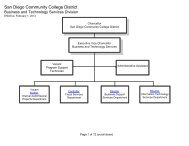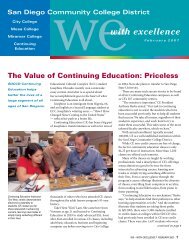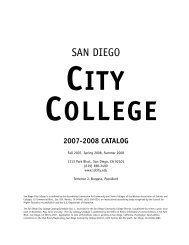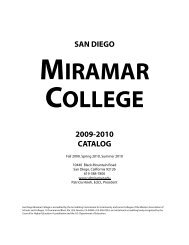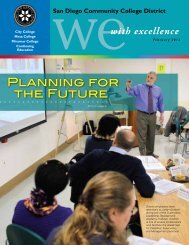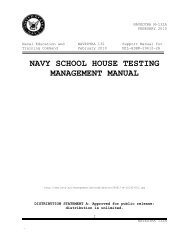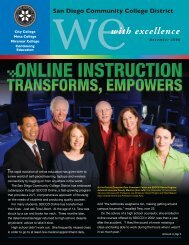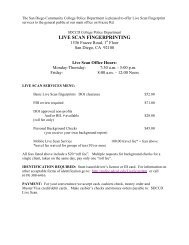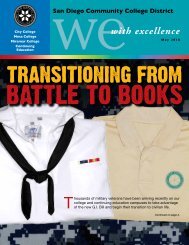CALIFORNIA
with excellence - San Diego Community College District
with excellence - San Diego Community College District
- No tags were found...
Create successful ePaper yourself
Turn your PDF publications into a flip-book with our unique Google optimized e-Paper software.
San Diego Community College District<br />
City College<br />
Mesa College<br />
Miramar College<br />
Continuing<br />
Education<br />
with excellence<br />
December 2010<br />
THE GREAT <strong>CALIFORNIA</strong><br />
Nearly everyone who has lived<br />
in San Diego for a year or two<br />
has experienced an earthquake.<br />
Most quakes are relatively mild with<br />
minimal property damage and few<br />
lives lost. The majority of San Diego’s<br />
earthquakes have been associated with<br />
the San Andreas Fault, the main fault<br />
line running through the state from<br />
Monterey to the Salton Sea.<br />
The last truly big quake on the<br />
southern section of the San Andreas<br />
Fault was a rupture of 7.9-magnitude<br />
in 1857, when few people lived in San<br />
Diego. It was so powerful that the soil<br />
liquefied in some places and swallowed<br />
entire trees. But even that may seem<br />
minor compared with the sort of quake<br />
that geologists now consider likely in<br />
coming years. Scientists used to say that<br />
enormous quakes occur every 250-450<br />
years along the southern portion of the<br />
fault. They now think the average is<br />
every 88 years.<br />
Continued on page 3.<br />
MAGNITUDE<br />
10<br />
9<br />
8<br />
7<br />
6<br />
5<br />
4<br />
3<br />
2<br />
GREAT EARTHQUAKE<br />
NEAR TOTAL DESTRUCTION<br />
MASSIVE LOSS OF LIFE<br />
MAJOR EARTHQUAKE<br />
SEVERE ECONOMIC IMPACT<br />
LARGE LOSS OF LIFE<br />
STRONG EARTHQUAKE<br />
DAMAGE ($ BILLIONS)<br />
LOSS OF LIFE<br />
MODERATE EARTHQUAKE<br />
PROPERTY DAMAGE<br />
LIGHT EARTHQUAKE<br />
SOME PROPERTY DAMAGE<br />
MINOR EARTHQUAKE<br />
FELT BY HUMANS<br />
EARTHQUAKES<br />
CHILE (1960)<br />
ALASKA (1964)<br />
CHILE (2010)<br />
NEW MADRID, MO (1812)<br />
SAN FRANCISCO, CA (1906)<br />
CHARLESTON, SC (1886)<br />
LOMA PRIETA, CA (1989)<br />
KOBE, JAPAN (1995)<br />
NORTHRIDGE, CA (1994)<br />
LONG ISLAND, NY (1884)<br />
Chancellor’s<br />
Message<br />
Constance M. Carroll, Ph.D.<br />
Chancellor, SDCCD<br />
UCSD - SDCCD: A Very Special Relationship<br />
In 1960, California enacted an ambitious, leading-edge<br />
blueprint for the future in its Master Plan for Higher<br />
Education. At the time, growing concern regarding the<br />
swelling population of “baby boomers” at the brink of college<br />
eligibility motivated the California legislature to develop and<br />
fund a precise system through which all eligible students could<br />
gain access to higher education.<br />
The University of California, the California State University,<br />
and the California Community Colleges saw their educational<br />
purposes defined, and the population greeted a new pathway<br />
of opportunity, more often than not starting at the community<br />
colleges and progressing through transfer to the universities.<br />
Now, celebrating its 50th anniversary, much of the initial<br />
fabric of the Master Plan is in tatters, as budget reductions<br />
and changes in academic policies have undermined the plan’s<br />
original concepts.<br />
The University of California, San Diego, stands out as<br />
an exception to this pattern. UCSD has remained faithful<br />
to its transfer relationships, especially with the San Diego<br />
Community College District’s three colleges – City, Mesa, and<br />
Miramar. Since 2005-06, when 247 transfer students attended<br />
UCSD from our colleges, the number has doubled to almost<br />
500 at the present time. The transferring students receive<br />
strong financial support and even have access to a “Transfer<br />
Village” in which to live on campus.<br />
There are other unique features of the UCSD-SDCCD<br />
relationship. Mesa College, in partnership with UCSD, offers<br />
an innovative program for underrepresented students who are<br />
interested in the biomedical sciences. Through a grant from the<br />
National Institutes of Health, the “Bridges to the Baccalaureate”<br />
program provides Mesa students with hands-on research<br />
experience and mentoring in the top-quality laboratories at<br />
UCSD even while they are engaged in their studies at Mesa.<br />
Additionally, the program compensates students for an eightweek,<br />
full-time summer internship at UCSD working with<br />
selected members of the faculty.<br />
City College collaborates with the Mechanical and Aerospace<br />
Engineering Department at UCSD in the California Space<br />
Grant Consortium. The consortium, facilitated by NASA,<br />
is focused on providing solutions to the challenges faced by<br />
City College President Terrence Burgess, UCSD Chancellor Marye Anne<br />
Fox, and SDCCD Chancellor Constance Carroll at a recent UCSD Transfer<br />
Day at City College.<br />
disadvantaged students in the STEM (Science, Technology,<br />
Engineering and Mathematics) pipeline. Specific activities and<br />
interventions associated with outreach, academic preparation,<br />
and research and assessment are planned for each educational<br />
segment of the pipeline (K-12, community college, upper<br />
division undergraduate and graduate).<br />
Among the scores of SDCCD students who transfer to the<br />
University of California system each year, there is a group<br />
who has distinguished themselves. These students are from<br />
our Honors Program. Over the years, the SDCCD Honors<br />
Program coordinators have worked closely with their UC<br />
counterparts to provide exclusive transfer agreements and other<br />
academic opportunities for our students. In particular, through<br />
the “CC2U” (community college to university) initiative at<br />
UCSD, students from City, Mesa, and Miramar colleges can<br />
take advantage of the Honors TAG (Transfer Admissions<br />
Guarantee) Program which provides scholarship, enrichment<br />
events, and conferences that “connect” them to UCSD.<br />
And, of course, the Chancellor of UCSD, Dr. Marye Anne<br />
Fox, is a frequent visitor to our campuses, lending her personal<br />
welcome and encouragement to prospective transfer students.<br />
From structured programs to special collaborations to personal<br />
commitment, the UCSD-SDCCD relationship is a great<br />
benefit to the San Diego region.<br />
2 San diego community college district
A sudden deep shift of the undersea plates close to the<br />
California coast on the scale of the 8.8-magnitude earthquake<br />
that rattled Chile earlier this year could also result in massive<br />
property damage in the billions of dollars and cause a<br />
substantial loss of life.<br />
Most of the Chilean fatalities were caused by a 40-foot<br />
tsunami wave that hit the shore during the middle of the night<br />
and obliterated nearly every dwelling in its path. The flooding<br />
that accompanied the wave caused fatalities several miles<br />
inland in low-lying areas. A tsunami wave of that size hitting<br />
Pacific Beach, Mission Beach, and Ocean Beach would destroy<br />
hundreds of residences and likely result in thousands of deaths<br />
and injuries.<br />
To prepare for the “Big One” in California and elsewhere<br />
along the unpredictable geological plates on Pacific Ocean’s<br />
U.S. and Canadian coasts, the ShakeOut drill was launched<br />
three years ago stimulated by scientists’ predictions of what<br />
would occur during and after a 7.8-magnitude earthquake<br />
along the 340-mile San Andreas Fault, considered one of the<br />
most dangerous in Southern California.<br />
AN INTERNATIONAL EARTHQUAKE<br />
PREPAREDNESS EFFORT<br />
From New Zealand and Guam to San Diego and Chicago,<br />
earthquake preparedness is serious business.<br />
On October 21, 2010, the SDCCD’s colleges and<br />
Continuing Education, Community-Campus Emergency<br />
Response Teams (C-CERT) swung into action as part of the<br />
San Diego region’s ShakeOut participation. Here is<br />
just a sample of the activities that took place.<br />
City College - The college’s C-CERT team was<br />
activated. Callback procedures were practiced, an<br />
evacuation drill of the Learning Resource Center<br />
was conducted, emergency radio procedures<br />
were rehearsed, campus emergency supplies were<br />
inspected, and a critique of their operation was held.<br />
Mesa College - The campus activated its<br />
C-CERT team, practicing their callback procedures,<br />
conducting mock building inspections as if an<br />
earthquake had occurred. They also handed out<br />
informational flyers on earthquake preparedness to<br />
faculty, staff and students as they walked about the<br />
campus. Faculty members who are C-CERT team<br />
members conducted special teach-in sessions about<br />
earthquake preparedness. The team held a postexercise<br />
critique of its operation.<br />
Miramar College - The campus C-CERT Team<br />
swung into action and held a training session to<br />
update members on their duties. Special campus<br />
issues dealing with newly constructed buildings and<br />
the rehabilitation of older buildings were reviewed.<br />
Continued from cover.<br />
Members fanned out across the campus and distributed<br />
earthquake preparedness materials. They also practiced callback<br />
and response procedures, and inspected their emergency<br />
supplies.<br />
Continuing Education - Staff members displayed emergency<br />
kits at each site and inventoried the contents. Informational<br />
sessions on earthquake preparedness were held for faculty, staff<br />
and students.<br />
District Office - The District’s emergency phone notification<br />
system was tested. Emergency supplies were inventoried and<br />
a display was set up showing the available supplies in the<br />
building along with the distribution of earthquake preparedness<br />
information.<br />
District Service Center/College Police - College Police<br />
conducted an emergency callback of off-duty personnel and the<br />
emergency paging systems were tested. The emergency supply<br />
bin was inspected and inventoried, and the expiration date<br />
of perishables was noted so a replacement schedule could be<br />
created.<br />
Several other San Diego area colleges participated in the<br />
ShakeOut, including: California State University, San Marcos,<br />
San Marcos; Grossmont-Cuyamaca Community College<br />
District, El Cajon; MiraCosta Community College District,<br />
Oceanside; National University, San Diego; Point Loma<br />
Nazarene University, San Diego; San Diego State University,<br />
San Diego; University of California, San Diego, La Jolla;<br />
University of San Diego, San Diego.<br />
1960 Chile tsunami (earthquake magnitude 9.5) maximum amplitude plot -<br />
for comparison with Feb 27, 2010 Chile tsunami event.<br />
We—With Excellence | December 2010 3
Terrence J. Burgess, Ph.D.<br />
President<br />
San Diego City College<br />
Want to Eat Healthier?<br />
Create an<br />
Edible Landscape.<br />
City College Professor Terri Hughes-Oelrich has had a dream<br />
to teach people to grow food and to “see young kids eat better,<br />
much better.” Working with students as young as elementaryschool<br />
age, Terri’s mantra is “gardening proves wonders.”<br />
Terri started gardening as a child with her family<br />
and always planted food wherever she lived after<br />
college. She is thrilled to be able to take her advocacy<br />
for nature’s foods to the next level by helping to<br />
develop the certificate program in Sustainable Urban<br />
Agriculture and Ecological Landscaping at City<br />
College. A first for southern California, the Certificate<br />
in Sustainable Urban Agriculture program teaches<br />
how to best use natural resources, reduce energy<br />
consumption, and lower CO2 emissions.<br />
Through hands-on experience working the urban<br />
farm, the certificate program will offer a new skilled<br />
workforce to transform urban spaces into edible<br />
landscapes. The program creates multiple career tracks<br />
related to sustainable agriculture, including urban<br />
farmer, market gardener, farm manager and farm/<br />
garden educator. Graduates can work for businesses,<br />
non-profit agencies, international organizations,<br />
governmental agencies, public institutions and<br />
educational institutions.<br />
Additionally, students may use the certificate as a<br />
foundation to continue with a related professional or<br />
academic focus in agriculture, plant science, biology,<br />
nutrition, culinary arts, public health, sustainable<br />
business models, urban design, landscape architecture,<br />
sustainable international development, environmental<br />
science, botany, horticultural therapy, conservation,<br />
alternative energy, and others.<br />
Currently Paul Maschka, the Seeds at City Urban<br />
Farm co-manager, is training SDCCD landscaping<br />
staff to use organic methods. Future plans also include<br />
developing an Associate in Science degree so students<br />
can transfer on to university programs.<br />
4 San diego community college district<br />
Terry Burgess, City College President said,<br />
“This Agricultural Certificate program is yet<br />
another branch in the extraordinary growth of<br />
the Seeds at City Urban Farm. The crop it yields is more about<br />
the students than the produce.”<br />
Always dreaming, Professor Hughes-Oelrich ponders,<br />
“Wouldn’t it be amazing if all the City of San Diego employees<br />
went through training at City College and the landscapers then<br />
only used organic methods? What a role model for the whole<br />
community that would be.”<br />
The development of this program and the launch of the new<br />
classes are funded through a San Diego Community College<br />
District Sustainability Initiative grant.<br />
Seeds at City is a joint project of San Diego City College and<br />
San Diego Roots Sustainable Food Project.
Elizabeth Armstrong<br />
Interim President<br />
San Diego Mesa College<br />
Expressions ofFaith and Teaching<br />
Four years ago, Jeff Berry was asked to volunteer as a<br />
translator for an El Cajon church youth group on an outreach<br />
mission to the small Mexican town of Vicente Guerrero. Of<br />
course he said yes. The Mesa College Professor of Spanish and<br />
co-chair of the Language Department did not hesitate to give<br />
up his spring break, but neither did he expect his life would be<br />
forever changed by the experience.<br />
Vicente Guerrero is an agricultural town about 200 miles<br />
south of San Diego. Everyone who is able to work does so in<br />
the fields six days a week for minimum wage of $345 pesos,<br />
or $26.20 in U.S. dollars. During times like Spring break -<br />
when school is out of session - the children are left to fend for<br />
themselves.<br />
That’s where the church volunteers step in. Some provide<br />
daily educational programs for the<br />
children, while others spruce up parks,<br />
clear trash, and repair playground<br />
equipment. On his first trip, Berry was<br />
assigned to work in the 13 de Mayo<br />
neighborhood and he “fell in love with<br />
the people and community.”<br />
He’s been going down every month<br />
or so ever since.<br />
In 2008, when the increased violence<br />
in Mexico caused the youth group to<br />
select outreach projects closer to home,<br />
Berry and a small group of adults<br />
continued the effort. Working with the<br />
local pastor in 13 de Mayo, they help<br />
the children, reach out to local gang<br />
members, and keep up on some small,<br />
ongoing building projects.<br />
But they were coming up short<br />
on supplies and items, and with a<br />
Christmas party coming up, Berry<br />
quietly approached his colleagues in the<br />
Languages Department at Mesa.<br />
“I was totally blown away (by their<br />
response),” he says. “There would be<br />
bags of toys left outside my office.”<br />
Adjunct and full-time instructors<br />
gave generously. Staff and students became involved and two<br />
students even went along to help.<br />
Last year, there was enough to host two parties, one in 13 de<br />
Mayo and another in Colonet. This year, Berry hopes to add a<br />
party in the village of Brisas, a migrant labor camp where the<br />
children are typically left alone all day while their parents work<br />
in the fields.<br />
Ask him about the commitment, coordination and effort it<br />
takes to make it all possible, and Berry explains that it is he who<br />
has been blessed, and his life that has been enriched.<br />
“It is an expression of my faith,” Berry explains. “It gives me<br />
great pleasure to be able to impact someone’s life and better<br />
their situation...I guess that is also part of why I became a<br />
teacher.”<br />
Posing as a holiday present, Jeff Berry is surrounded by children at the annual holiday gathering.<br />
We—With Excellence | December 2010 5
Patricia Hsieh, Ed.D.<br />
President<br />
San Diego Miramar College<br />
Dynamic Sibling Duo Comes Home to Lead<br />
Sean and Rebecca Bowers grew up in Mira Mesa and played<br />
in the fields that would become the Miramar College campus.<br />
The brother and sister graduated from Mira Mesa High School,<br />
Miramar College, and universities 2,000 miles apart. They<br />
pursued very different careers, married and started families.<br />
Little did they know that one day they’d return “home” to work<br />
side-by-side at their community college alma mater.<br />
In 2006, soccer superstar Sean Bowers joined the Miramar<br />
College faculty and helped launch the first women’s soccer<br />
program in college history. In the last four years, he’s coached<br />
the lady Jets to four straight Pacific Coast Conference winning<br />
seasons with an overall record of 61-18. This year, they were<br />
named Pacific Coast Conference champs.<br />
An all-star defender, Bowers played for the MLS Kansas City<br />
Wizards, was a 2002 MISL All-Star and the league’s Defender<br />
of the Year with the Baltimore Blast, before serving as the team’s<br />
interim head coach in 2002-2003. Bowers was acquired by the<br />
San Diego Sockers in 2002 and led the professional indoor<br />
soccer team to an MISL Championship title. In 2004, Bowers<br />
was named to the U.S. Futsal National Team as captain.<br />
Today, in addition to teaching and coaching at Miramar,<br />
Bowers is back with the San Diego Sockers (reintroduced<br />
under new leadership), who clinched the national title in their<br />
comeback season of play earlier this year. Their second season<br />
kicks off November 20.<br />
Baby Sister Rebecca Bowers-Gentry has established her own<br />
successful record with another Miramar College program –<br />
biotechnology – starting as an adjunct teacher in 2003 and<br />
becoming a full-time faculty member three years later.<br />
After receiving her bachelor’s and master’s degrees from San<br />
Diego State University and her Ph.D. in cellular/molecular<br />
biology from the University of Colorado Dr. Bowers joined the<br />
research team at UCSD, where she realized her preference for<br />
the student contact that teaching provided.<br />
Under a newly funded $400,000 American Recovery<br />
and Reinvestment Act (ARRA) grant, the college expanded<br />
classroom capacity in the applied biotechnology program,<br />
led by Bowers-Gentry. The certificate program is designed to<br />
include three technical courses, basic skills, workplace readiness<br />
and academic support, and span three semesters. Its first cohort<br />
graduated in May. Of the 21<br />
graduates, one advanced to graduate<br />
school, one entered a full-year paid<br />
internship in stem cell research<br />
and five found employment in the<br />
biotechnology industry.<br />
Dr. Sandra Slivka, director of the<br />
Southern California Biotechnology<br />
Center at Miramar College, noted<br />
that, a Salk Institute human<br />
resources officer, who interviewed<br />
four of the graduating class for one<br />
vacancy, were “all well qualified and<br />
it was a hard decision to select just<br />
one.”<br />
Currently, 54 students are<br />
enrolled in the accelerated<br />
certificate program.<br />
Whether it’s on the campus soccer field<br />
cheering on the lady Jets, in their offices<br />
next door to each other, or visiting their<br />
parents who still live in their childhood<br />
home one block from the campus, this<br />
dynamic duo is one “close knit family.”<br />
6 San diego community college district
Anthony E. Beebe, Ed.D.<br />
President<br />
San Diego Continuing Education<br />
I-BEST<br />
By Guest Columnist, Continuing Education<br />
Basic Skills Instructor Corle Huffman<br />
Think back to your lazy middle-school afternoons, remember<br />
a yellow #2 pencil napping between your thumb and forefinger<br />
and trying to solve a math problem that calculated 75% of 79.<br />
You may have asked your teacher why you needed to learn it,<br />
only to hear, “If you ever become a bridge builder you’ll need to<br />
know it.”<br />
If you remember turning off your brain at some point during<br />
situations like this, then you will appreciate the more studentcentered<br />
approach to learning that Continuing Education has<br />
implemented with the I-BEST model.<br />
I-BEST (Integrated Basic Education Skills Training) is<br />
contextualized learning, or learning in context.<br />
“I-BEST represents a fundamental shift in pedagogy for<br />
basic skills instruction. Our students are afforded a highly<br />
relevant educational experience. This, in addition to the cohort<br />
experience, motivates them to be more successful,” Continuing<br />
Education Vice President Brian Ellison stated.<br />
The potency of contextualized learning is not a secret.<br />
Washington State has been using the I-BEST model successfully<br />
since 2002, pairing vocational training with contextualized<br />
basic skills through a team-teaching environment.<br />
Modeling best-practices from Washington State and using<br />
their existing Allied Health program, Continuing Education<br />
President Anthony Beebe and the I-BEST team of faculty<br />
and administrators have established an I-BEST model at<br />
Continuing Education, the first of its kind in California.<br />
“I-BEST takes what we have known for centuries about how<br />
students learn and brings it to life in the classroom. Students<br />
don’t wonder why they are learning something. Instead,<br />
students follow the instructor and understand why they need to<br />
learn the material,” Dr. Beebe explained.<br />
From pre-test to post-test, students have shown an increase of<br />
15% or 1.5 letter grades, in as little as six weeks. Additionally,<br />
one in every six students moved from below 60% (a grade F)<br />
to above 90% (a grade A). “We wanted to build a specific and<br />
accelerated pathway into higher education. The empirical results<br />
of our students’ success rates prove that we have done exactly<br />
that,” said John Lindem, I-BEST Program Coordinator.<br />
Students were surprised at their own success. “This class<br />
helped me ace the TEAS,” said Sarah McKinsey, referring to<br />
the Test of Essential Academic Skills (TEAS). Another student,<br />
Maria, said, “With I-BEST, I have been able to study nursing<br />
and basic skills at the same time. This means I can find a better<br />
job and quicker.”<br />
I-BEST is embedded within Nursing Assistant training<br />
classes, the Welding and Structural Fabrication program, and<br />
a VESL (Vocational English as a Second Language) Personal<br />
Assistant/Caregiver class.<br />
Recently, the I-BEST VESL class was awarded a 2010<br />
Promising Practices Award by the CASAS (Comprehensive<br />
Adult Student Assessment Systems) Awards Review Team, in<br />
coordination with the California Department of Education.<br />
Continuing Education<br />
student Jorge Canales<br />
We—With Excellence | December 2010 7
kudos<br />
Accomplishments & Achievements<br />
CAEL Learner of the Year<br />
Continuing<br />
Ed. Gets<br />
Two Golds<br />
The newly constructed<br />
Educational Cultural Complex<br />
Skills Center and West City<br />
Campus have been awarded<br />
Leadership in Energy and<br />
Environmental Design (LEED)<br />
Gold Certifications for<br />
sustainable and green design by<br />
the United States Green Building<br />
Council (USGBC).<br />
The Skills Center, which opened in September 2009<br />
as the District’s Campus of Excellence for Career and<br />
Technical Education, is the District’s fifth facility to be<br />
LEED-certified, and third to achieve a LEED Gold.<br />
The 67,010 square foot facility supports instructional<br />
and career training programs in high demand, including<br />
automotive technology, automotive mechanical and<br />
electrical repair, automotive body repair, automotive<br />
upholstery, graphic printing technology, computer graphic<br />
arts, Cisco Lab, business information technology and<br />
welding.<br />
In Point Loma, the new two-story West City Campus<br />
serves as Continuing Education’s Campus of Excellence for<br />
Hospitality Services and Consumer Science.<br />
The 39,000 square foot facility houses a state-of-theart<br />
culinary arts kitchen, and technology-rich classrooms<br />
designed to enhance student skills in sewing, fashion,<br />
business information technology, English for non-native<br />
English Speakers, parent education and arts.<br />
The campus, which opened in January 2009, also offers<br />
an extensive Emeritus Program (classes for age 55+).<br />
Construction of both facilities was funded by the<br />
District’s $1.555 billion Propositions S & N bond<br />
program. Under the Green Building Policy developed<br />
by the SDCCD Board of Trustees, all bond-funded<br />
construction and major renovations are designed and built<br />
to obtain, at minimum, LEED Silver certification.<br />
8 San diego community college district<br />
CAEL, the Council for Adult<br />
and Experiential Learning,<br />
selected Continuing Education<br />
graduate Esther Alvarado<br />
(pictured) as CAEL Learner of<br />
the Year. Alvarado left middle<br />
school without being able to<br />
read or write, and did not<br />
return to the classroom for 20+<br />
years. After spending significant<br />
time with CE counselor Lola<br />
Gaona, to understand her options at Continuing Education<br />
(including Disability Support Programs and Services), Alvarado<br />
met her goal of being able to read and write, and completed her<br />
GED. She graduated in June 2010 as the representative student<br />
speaker at CE’s Commencement and is currently pursuing an<br />
Associate degree in Social Work at Mesa College.<br />
Each year, CAEL honors individuals who have overcome<br />
significant barriers in achieving his or her educational goals.<br />
Alvarado will receive the award during the CAEL International<br />
Conference in November.<br />
A+ for Citizenship<br />
Gretchen Bitterlin,<br />
Continuing Education<br />
ESL Instructor and<br />
Program Chair,<br />
participated in the<br />
TESOL meeting<br />
(Teachers of English<br />
to Speakers of Other<br />
Languages) a technical<br />
advisory group to<br />
the United States<br />
Citizenship and<br />
Immigration Services<br />
in Washington, D.C.,<br />
over the summer<br />
to give input and<br />
recommendations<br />
ESL Program Chair Gretchen Bitterlin<br />
pictured with student Endesh Woreta<br />
(center) and Citizenship Instructor Colleen<br />
Fitzmaurice. Woreta recently passed the U.S.<br />
Citizenship exam.<br />
on the Citizenship exam for the United States. Continuing<br />
Education offers free preparation classes for the exam at four<br />
main campuses and serves approximately 800 students annually.
kudos<br />
Accomplishments & Achievements<br />
Allied Health Building – Good as Gold<br />
The year-old Mesa College Allied Health Education and<br />
Training Facility has been awarded Leadership in Energy<br />
and Environmental Design (LEED) Gold Certification for<br />
sustainable and green design by the United States Green<br />
Building Council (USGBC).<br />
The Allied Health building, which opened in August 2009,<br />
is SDCCD’s sixth facility to be LEED certified, and fourth<br />
to achieve a LEED Gold. The three-story, 50,000 square foot<br />
building provides training facilities and classroom space for<br />
degree and certificate programs in five healthcare fields: Dental<br />
Assisting, Health Information Technology, Medical Assisting,<br />
Physical Therapy Assistant and Radiologic Technology. The San<br />
Diego Workforce Partnership identified four of these as among<br />
Women’s<br />
Soccer<br />
Claims Title<br />
Congratulations, Coach Sean<br />
Bowers, assistant coaches and the<br />
Miramar Women’s Soccer Jets on<br />
their Pacific Coast Conference<br />
championship! With a season record<br />
of 18 wins/1 loss, the lady Jets<br />
dominated the conference!<br />
the 10 most in-demand fields through<br />
2014.<br />
“We are really pleased to exceed the<br />
Board of Trustees policy by seeing our<br />
buildings qualify at an even higher level,”<br />
said Chancellor Constance Carroll.<br />
The building’s sustainable features<br />
include:<br />
• Maximum use of natural lighting.<br />
• All windows utilize ‘high performance’<br />
glass that allows sunlight to filter into<br />
the building, but reduces the amount<br />
of UV light and solar heat entering the<br />
building.<br />
• All walls and roof areas are highly<br />
insulated.<br />
• Energy efficient design and features help Allied Health<br />
exceed state energy requirements by 7.4 percent.<br />
• Some of its energy<br />
comes from the<br />
photovoltaic<br />
panels on the<br />
nearby parking<br />
structure, boosting<br />
the building’s<br />
energy efficiency<br />
cost savings to<br />
58.7 percent.<br />
We—With Excellence | December 2010 9
kudos<br />
Accomplishments & Achievements<br />
Student Health Services Honored<br />
The San Diego Blood<br />
Bank honored City College<br />
Student Health Services for its<br />
sponsorship of multiple blood<br />
drives on the campus throughout<br />
the year and for exceeding its<br />
collection goals. Last Year City<br />
College collected 80 blood pints,<br />
and this year it collected<br />
277 pints.<br />
City College President Terry Burgess<br />
and Student Health Services<br />
Director Dotti Cordell<br />
Photo credit: Carlos Maia<br />
Record Numbers!<br />
Seven City College students were awarded the<br />
prestigious Benjamin A. Gilman study abroad<br />
scholarship for Fall 2010. Sponsored by the U.S.<br />
Department of State, Bureau of Educational and<br />
Cultural Affairs, the Gilman award amounts were<br />
from $2,500 to $5,000.<br />
Five of the awards were for City College’s<br />
program to Buenos Aires, one was for the<br />
SDICCCA study abroad consortium program to<br />
Barcelona, Spain, and one is for study in London.<br />
Marion Froehlich, M.A., International<br />
Education Coordinator and Immigration Specialist<br />
at San Diego City College noted, “This is the<br />
highest number of Gilman scholarships ever<br />
awarded to City College students in one semester!”<br />
C-CERTified Employees<br />
At exactly 10:21 a.m. on Oct. 21, the Mesa College<br />
community “dropped, covered, and held on” as part of the<br />
Great California Shakeout, the annual statewide earthquake<br />
preparedness program. Instantly, the college’s C-CERT<br />
emergency response team, led by Mesa College C-CERT<br />
Coordinator Charlotta Robertson and SDCCD Police Officer<br />
Diana Medero, swung into action, just as if a real earthquake<br />
disaster had occurred. For the next hour, the C-CERT<br />
volunteers set up a command center in front of the LRC and<br />
dispatched teams to inspect and report on the status of all areas<br />
of the campus.<br />
The hands-on drill demonstrated the skill<br />
of Mesa’s amazing team of 43 campus-wide<br />
administrators, staff, faculty, and law enforcement<br />
personnel who received three-days of intense<br />
Campus Community Emergency Response<br />
Team Training (C-CERT) this past summer. The<br />
training covered everything from CPR/First Aid<br />
to Disaster Preparedness, Disaster Psychology<br />
and Search and Rescue efforts. “The Mesa and<br />
District campus communities can feel much safer<br />
with C-CERT qualified members that are better<br />
prepared and ready to respond to emergencies<br />
and disasters,” said Robertson. C-CERT training<br />
is being conducted throughout the district and coordinated by<br />
SDCCD Chief of Police Charlie Hogquist.<br />
C-CERTified Olympians: Ana De Orlow; Ashanti<br />
Hands; Barbara Plandor; Barbara Young; Barry Coleman;<br />
Charles Zappia; Charlotta Robertson; Danielle Short;<br />
Dave Warczakowski; Diana Medero; Dion Aquino; Farideh<br />
Farheidar; Jackie Szitta; Jennifer Simley; Jonathan Fohrman;<br />
Jose Lopez; Ken Berger; Kevin Krown; Leroy Johnson; Lina<br />
Heil; Lynn Dang; Margie Fritch; Marichu Magana; Matt<br />
Flores; Mavis La Vay; Melvin Clay; Michael Lewis; Michael<br />
McLaren; Michael Reese; Michele Marbrey; Nathan Talo; Nick<br />
Johns; Noel Tabor; Penny Hedgecoth; Rob Fremland; Robin<br />
Watkins; Sara Beth Cain; Sue Lalicker; Tim McGrath; Victor<br />
Bocaya; Zod Schultz.<br />
10 San diego community college district
kudos<br />
Accomplishments & Achievements<br />
LLRC TOPPING OFF<br />
Miramar College faculty and staff, SDCCD and community representatives gathered with<br />
contractors and construction crewmembers recently for a ceremonial “topping off” of the<br />
Miramar College Library and Learning Resource Center (LLRC) project. A 25' long steel<br />
beam, one of over 1,700 used for the LLRC, was signed by guests, and adorned with an<br />
American flag and palm tree before being hoisted by a 165-ton crane to its final position.<br />
The “topping off” practice started in Scandinavia over 1,000 years ago, when workers<br />
traditionally erected an evergreen tree with the highest structural element as symbol of good<br />
faith and good luck.<br />
The $37.4 million, three-story LLRC will include a new library, state-of-the-art classrooms<br />
and computer labs, tutoring services, a media production facility and faculty and staff offices<br />
and work spaces. Construction began in December 2009 and is expected to be completed in<br />
October 2011.<br />
The building is designed to obtain a Leadership in Energy and Environmental Design<br />
(LEED) Silver certification by the United States Green Building Council (USGBC), and<br />
includes many sustainable features.<br />
Miramar College Library and Learning<br />
Resource Center<br />
Medical Lab<br />
Tech Approved<br />
The Medical Laboratory<br />
Technician Training<br />
(MLTT) program at<br />
Miramar College has<br />
received official approval<br />
from the California<br />
Department of Public<br />
Health Laboratory Field<br />
Services, Personnel<br />
Licensing and Certification,<br />
on September 1st.<br />
Formal accreditation by<br />
the California Department<br />
of Public Health allows<br />
students who graduate<br />
from Miramar’s MLTT<br />
program to sit for the<br />
examination required to<br />
become a licensed medical<br />
laboratory technician in the<br />
State of California. Students<br />
currently enrolled in the<br />
program will graduate in<br />
May 2011.<br />
GREEN FUTURE<br />
FOR <strong>CALIFORNIA</strong><br />
On November 4, Miramar College hosted the<br />
State Assembly Selected Committee on California’s<br />
Green Economy Chaired by Assemblymember<br />
Pedro Nava (D-Santa Barbara) for an informational<br />
briefing regarding green jobs and technology.<br />
The Select Committee has been holding a series<br />
of hearings throughout the state recently to hear<br />
from universities, local government, businesses, and<br />
the public about efforts and ideas to help the green<br />
economy grow more rapidly and get Californians<br />
back to work.<br />
Miramar College was selected as the San Diego<br />
regional site, based on the College and District<br />
reputation for advancement of “green” initiatives<br />
in alternative fuels and energy, job training and<br />
construction.<br />
Following welcome remarks from SDCCD<br />
Trustee Peter Zschiesche, SDCCD Chancellor<br />
Constance Carroll and Miramar College President<br />
Patricia Hsieh, three panels of experts addressed<br />
the Assemblymember and audience. SDCCD Vice<br />
Chancellor Dave Umstot and Miramar Dean Greg<br />
Newhouse were among the panelists.<br />
with excellence<br />
Published by the<br />
San Diego<br />
Community College District<br />
Office of Public Information<br />
& Government Relations<br />
619-388-6500 • www.sdccd.edu<br />
Executive Editor: Richard Dittbenner<br />
Editor: Mary Lee<br />
Graphic Design: Cesar Gumapas<br />
Contributions from:<br />
City College Communications Services<br />
Mesa College Communications Services<br />
Miramar College Communications Services<br />
Continuing Education Communications Services<br />
The San Diego Community College District is<br />
governed by its Board of Trustees. No oral or<br />
written representation is binding on the San Diego<br />
Community College District without the express<br />
written approval of the Board of Trustees.<br />
December 2010<br />
We—With Excellence | December 2010 11
San Diego Community College District<br />
Administrative Offices<br />
3375 Camino del Rio South<br />
San Diego, CA 92108-3883<br />
Board of Trustees:<br />
Mary Graham<br />
Rich Grosch<br />
Bill Schwandt<br />
Maria Nieto Senour, Ph.D.<br />
Peter Zschiesche<br />
Chancellor:<br />
Constance M. Carroll, Ph.D.<br />
This Garden Rocks!<br />
A new, low-water use natural garden is taking shape and<br />
form at San Diego Mesa College in what was once a waterguzzling<br />
patch of sod in front of the LRC and next to the<br />
B-100 building. Low-water use landscapes have already been<br />
incorporated into new Propositions S & N construction<br />
projects across the SDCCD, but this is the first project to<br />
transform existing landscape and the first to feature San Diego<br />
native plants. Once the plants are established, water usage is<br />
expected to be cut up to 70 percent in the summer and 100<br />
percent during the winter months.<br />
Credit goes to Regional Facilities Officer Deb Canning<br />
and groundskeepers Tony Provenzano, Rosalio Fuentes,<br />
Mo Katawazi, Kris Doonan, Anthony Burt, and Dave<br />
Warczakowski.



